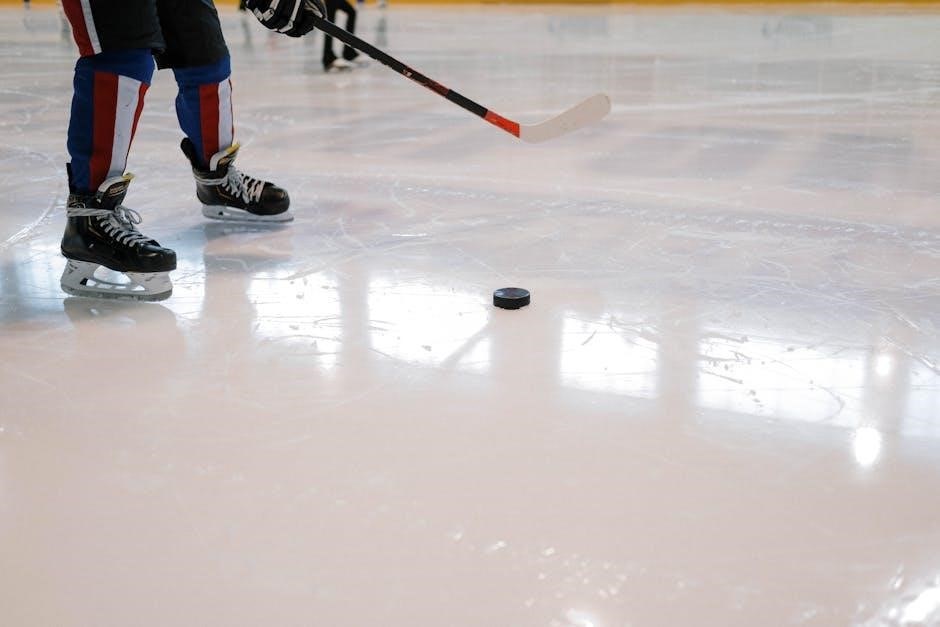Snare drumming is a foundation of rhythm and timing in music. Stick control is essential for precision, dynamics, and expression. Mastering it enhances musical accuracy and confidence.
The Importance of Stick Control in Snare Drumming
Stick control is the cornerstone of snare drumming, enabling precise rhythmic execution and dynamic expression. It ensures consistency in tone, timing, and technique, allowing drummers to perform with confidence and accuracy. Mastering stick control enhances versatility, making it easier to adapt to various musical styles and complexities. Without strong stick control, even the most advanced techniques can suffer from poor timing or inconsistent sound quality, making it a fundamental skill for every snare drummer to develop and refine.
Understanding Stick Control Basics
Stick control forms the foundation of snare drumming, focusing on consistent strokes, coordination, and rhythmic accuracy. It involves mastering basic movements and transitions between them seamlessly.
What is Stick Control?
Stick control refers to a drummer’s ability to manipulate sticks with precision, affecting touch, dynamics, and rhythmic accuracy. It involves consistent grip, stroke types, and movement control, enabling expressive and technically proficient playing. Proper stick control enhances sound quality, coordination, and overall musicality, making it a fundamental skill for snare drummers. Mastery requires dedicated practice and attention to detail, as it directly impacts performance quality and artistic expression.
Key Components of Stick Control
Stick control encompasses grip, stroke types, and movement precision. Proper grip balance is vital for consistency; Stroke height and rebound control affect dynamics and sound quality. Rhythmic accuracy ensures precise timing. Control also involves finger independence, wrist movement, and arm alignment. These elements collectively enable nuanced expression and technical proficiency. Mastery of these components enhances overall performance and musicality, making stick control a cornerstone of snare drumming technique.
Proper Grip and Stance for Snare Drumming
A correct grip involves balanced pressure between thumb and fingers. The stick should rest in the fulcrum of the hand. The stance requires feet shoulder-width apart, knees slightly bent. Posture should be upright with hips aligned. The drum should be positioned at waist height, allowing arms to hang naturally. Proper alignment ensures efficient movement and reduces fatigue. A relaxed yet controlled posture supports precise stick control and prevents injury, fostering optimal technical execution and musical expression during performance.

The Role of Rudiments in Stick Control
Drum rudiments are fundamental patterns that form the basis of rhythmic technique. They enhance coordination, precision, and overall control, essential for mastering snare drumming effectively.
Drum rudiments are the foundational patterns of drumming, forming the basis of rhythmic technique. They include basic sticking patterns like the single stroke roll, double stroke roll, and paradiddle. Rudiments help develop coordination, consistency, and control, essential for precision and musicality. By mastering these patterns, drummers build the technical skills needed for complex rhythms and expressions. Rudiments are universally applied across all drumming styles, making them a critical starting point for any drummer aiming to achieve proficiency in stick control and overall performance.
How Rudiments Apply to Snare Drumming
Drum rudiments are fundamental to snare drumming, providing the technical foundation for stick control and rhythmic accuracy. Rudiments like the single stroke roll and double stroke roll improve dexterity, while the paradiddle and flam taps enhance coordination and expression. By mastering these patterns, drummers develop consistency and precision, essential for executing complex rhythms and maintaining musicality. Rudiments are directly applicable to snare drumming, helping players achieve clarity, dynamics, and control in their performance. They form the building blocks for advanced techniques and are indispensable for any serious snare drummer.
Mastering Essential Rudiments for Stick Control
Mastering essential rudiments is crucial for developing stick control in snare drumming. Rudiments like the single stroke roll, double stroke roll, and paradiddle form the foundation of rhythmic precision. Practicing these patterns slowly with a metronome ensures consistency and accuracy. Focused exercises, such as playing rudiments with both hands independently, improve dexterity and coordination. As muscle memory develops, drummers can execute rudiments seamlessly, enhancing overall technical proficiency and musical expression. Regular practice of these fundamentals is key to achieving advanced stick control and versatility in snare drumming.
Practice Strategies for Improving Stick Control
Consistent practice with focused exercises, metronomes, and goal-setting is essential. Regular drills, slow tempos, and precise movements build dexterity, coordination, and rhythmic accuracy over time.
The Importance of Slow, Deliberate Practice
Slow, deliberate practice is crucial for developing precise stick control. It allows drummers to focus on proper technique, ensuring accurate strokes and consistent timing. By practicing slowly, musicians can build muscle memory, reduce errors, and enhance overall coordination. This method also helps in understanding complex rhythms and dynamics. Over time, slow practice lays a strong foundation for increasing speed and complexity in performances. It is essential to prioritize quality over quantity, making every stroke intentional and controlled.
Using Focused Exercises for Stick Control
Targeted exercises are vital for refining stick control. Simple rudiments, limb independence drills, and precise stroke practices help build dexterity and coordination. Focused exercises improve accuracy, consistency, and overall technique. By isolating specific movements, drummers can address weaknesses and develop muscle memory. Regular practice with a metronome ensures timing accuracy. These exercises also enhance dynamics and touch, allowing for more expressive playing. Consistent use of focused drills lays the groundwork for advanced techniques and confident performances in various musical settings.
Incorporating Musical Context into Practice
Practicing stick control within a musical context enhances its practical application. Drummers should apply rudiments to real-world scenarios, such as grooves or fills, to develop versatility. Understanding phrasing, dynamics, and genre-specific styles ensures that technical skills translate to meaningful performances. Listening to professional drummers and studying their approach to stick control in various musical settings provides inspiration and direction. By integrating musical context, practice becomes more engaging and relevant, fostering a deeper connection between technique and artistic expression.
Setting Goals and Tracking Progress
Setting specific, achievable goals is crucial for improving stick control. Drummers should define short-term and long-term objectives, such as mastering a rudiment or increasing speed. Tracking progress through practice journals, recordings, or metronome exercises helps maintain motivation. Celebrating milestones builds confidence and encourages consistent practice. Regularly reviewing goals ensures they remain relevant and challenging. Adjustments can be made as skills improve, keeping the practice journey focused and rewarding. This structured approach fosters discipline and measurable growth in stick control development.

Common Mistakes to Avoid
Common mistakes include over-tightening the grip, playing with excessive stroke height, ignoring rhythmic accuracy, and over-practicing without rest, all hindering progress and causing fatigue.
Over-Tightening the Grip

Over-tightening the grip is a common mistake that restricts stick movement and causes fatigue. A relaxed grip allows better control and precision. It can lead to discomfort and reduced dexterity, affecting overall performance. Drummers often grip tightly due to nervousness or lack of practice; To avoid this, practice with a balanced grip, focusing on finger independence. Proper grip technique ensures optimal stick control and prevents long-term injury. Regular exercises can help develop the correct muscles, improving both comfort and accuracy during performances.
Playing with Excessive Stroke Height
Playing with excessive stroke height can reduce accuracy and control. Higher strokes often lead to fatigue and slower execution. They can also limit precision, as the stick’s descent becomes less predictable. Drummers should aim for lower, controlled strokes to maintain consistency and speed. Practicing with a metronome helps develop proper stroke height and timing. Additionally, recording sessions or using a mirror can provide visual feedback to correct this habit. Proper stroke height ensures better stick control, enabling more precise and dynamic performances while preserving energy and focus during extended playing sessions.
Ignoring Rhythmic Accuracy
Ignoring rhythmic accuracy can significantly hinder a drummer’s performance. It leads to poor timing, causing the music to feel disjointed or unprofessional. Rhythmic inaccuracy can also make it difficult for other musicians to follow the beat, disrupting the overall musical cohesion. Drummers must prioritize precise timing to maintain clarity and musicality. Practicing with a metronome and focusing on subdivisions can help improve rhythmic accuracy. Additionally, recording performances and analyzing them can reveal timing errors, allowing for targeted corrections. Accurate rhythm is foundational to effective stick control and musical expression.
Over-Practicing Without Rest
Over-practicing without rest can lead to physical fatigue, reducing technique quality and increasing injury risk. Muscular strain and mental exhaustion often result, hindering progress. Consistent breaks are essential to avoid burnout and maintain focus. Without rest, even the most dedicated practice sessions become counterproductive. Balance is key to sustainable improvement in stick control and overall drumming performance. Prioritizing rest ensures longevity and continuous growth as a musician.
Advanced Techniques for Stick Control
Advanced techniques involve mastering complex rudiments and dynamics. Drummers develop precision, touch, and control for intricate rhythms. These skills enhance musicality and versatility in performance.
Developing Dynamics and Touch
Developing dynamics and touch requires precision and control. Drummers learn to play with varying volumes, from subtle pianissimo to powerful fortissimo. Proper technique ensures clarity and expression. Touch refers to how sticks interact with the drumhead, influencing tone quality. Practicing rudiments with dynamic control enhances musicality. Mastery of these elements allows drummers to convey emotion and depth in their playing, making their performances more engaging and nuanced. Consistent practice is essential to refine these advanced skills.

Mastering Complex Time Signatures
Mastering complex time signatures requires a deep understanding of rhythm and timing. Drummers must develop the ability to play accurately in unusual meters, such as 5/4 or 7/8. Stick control is crucial for maintaining consistency and clarity in these challenging time signatures. Practicing with a metronome helps build precision and confidence. Limb independence and coordination are essential for executing intricate rhythmic patterns. Breaking down complex rhythms into smaller, manageable parts can simplify the learning process. Over time, this skill enhances overall rhythmic accuracy and versatility in performance.
Incorporating Advanced Rudiments
Incorporating advanced rudiments like the paradiddle, flamingo, and dragonmouth into your practice enhances stick control and technical proficiency. These complex patterns challenge coordination and dexterity, requiring precise wrist and finger movements. Advanced rudiments expand your rhythmic vocabulary, allowing for more intricate and expressive playing. Start by practicing rudiments at slow tempos, focusing on clarity and accuracy. Gradually increase speed as control improves. Incorporating these rudiments into musical contexts helps develop versatility and confidence in performance, making them indispensable for advanced snare drumming.

The Role of Technology in Stick Control
Technology enhances stick control through metronomes, recording tools, and practice apps. These resources improve timing, technique, and consistency, offering valuable feedback for skill development and progress tracking.
Using a Metronome for Precision
A metronome is an essential tool for developing precision in stick control. It helps maintain a consistent tempo, improving timing accuracy and rhythmic awareness. By practicing with a metronome, drummers can enhance their ability to play complex rhythms and time signatures with confidence. It also aids in building muscle memory, ensuring that strokes are executed precisely and consistently. Whether focusing on rudiments or intricate snare drum passages, a metronome provides a reliable foundation for precise and controlled playing, making it a cornerstone of effective practice routines.
Recording and Analyzing Your Playing
Recording your practice sessions is a powerful way to identify and improve weaknesses in stick control. By capturing your playing, you can objectively assess timing, dynamics, and technique. Analyzing recordings helps pinpoint errors, ensuring precise corrections. Over time, this process reveals progress and highlights areas needing refinement. Use smartphone apps, digital recorders, or software to capture high-quality audio. Regular review fosters awareness and accountability, driving consistent improvement in stick control and overall musicianship.

Apps and Software for Drummers
Various apps and software tools are available to aid drummers in improving stick control. Applications like Tempo, Time Trainer, and Drumeo offer metronomes, practice exercises, and lesson plans tailored for snare drumming. Software such as Logic Pro X and Ableton Live allow for recording and analyzing performances. These tools provide customizable exercises, performance tracking, and real-time feedback, helping drummers refine their technique and maintain consistent progress in stick control and overall musicianship.
Maintaining Consistency in Practice
Regular, focused practice is essential for improving stick control. Set achievable goals, track progress, and incorporate exercises into a daily routine to build muscle memory and precision.
Building a Daily Practice Routine
A consistent daily practice routine is crucial for developing stick control. Begin with warm-ups to relax the hands and focus the mind. Dedicate time to rudiments, starting with slow tempos and gradually increasing speed. Incorporate exercises that emphasize precision and timing, such as single strokes and paradiddles. Practice along with music to apply rudiments in a musical context. End with a cool-down to stretch and relieve tension. Consistency, even in short sessions, builds muscle memory and improves technique over time. Avoid burnout by balancing challenge and enjoyment.
Developing Muscle Memory
Muscle memory is essential for stick control, enabling automatic execution of strokes without conscious thought. Repetition of rudiments and exercises at a slow, controlled tempo helps embed patterns into your motor skills. Consistency in practice, even for short durations, reinforces muscle memory. Avoid bad habits by focusing on proper technique from the start. Over time, muscle memory reduces mental fatigue, allowing you to perform complex patterns with ease and precision, making your playing more fluid and expressive during performances.
Avoiding Burnout and Staying Motivated
Avoiding burnout requires balancing practice with rest to prevent mental and physical fatigue. Set achievable goals and celebrate progress, no matter how small. Incorporate variety in your practice routine to keep it engaging. Embrace challenges as opportunities to grow rather than sources of frustration. Stay motivated by remind yourself of your passion for drumming and its benefits. Listening to professional drummers and setting long-term aspirations can also inspire persistence and enjoyment in your journey to master stick control.

The Benefits of Stick Control
Stick control enhances dexterity, coordination, and musical expression, allowing for precise rhythmic execution and dynamic range. It builds confidence and mastery in performance, essential for professional drumming.
Improved Dexterity and Coordination
Stick control significantly enhances dexterity by refining finger, wrist, and arm movements, allowing for precise strokes. It improves coordination by synchronizing limb independence, ensuring accurate execution of complex rhythms and rudiments. Regular practice strengthens muscle memory, enabling drummers to perform intricate patterns effortlessly. Enhanced dexterity and coordination empower snare drummers to deliver crisp, clean sounds with greater consistency and control, elevating overall performance quality and musical expression.
Enhanced Musicality and Expression
Stick control fosters musicality by enabling precise dynamics, phrasing, and timing, allowing drummers to convey emotion through their playing. It enhances expression by providing the tools to execute subtle variations in touch and stroke, adding depth to performances. With improved control, drummers can interpret music more effectively, delivering nuanced and engaging renditions. This refinement in technique elevates the drumline’s overall impact, making their sound more polished and emotionally resonant. Stick control is essential for transforming technical skill into meaningful musical communication.

Increased Confidence in Performance
Stick control directly enhances performance confidence by ensuring consistency and reliability in execution. When drummers can trust their technique, they feel more secure in their ability to perform accurately. This reliability reduces anxiety, allowing them to focus on the music rather than technical concerns. Mastery of stick control fosters a sense of self-assurance, enabling drummers to approach performances with poise. The ability to execute strokes confidently translates to a more engaging and polished presentation, making the performance experience more enjoyable for both the drummer and the audience.

Resources for Further Learning
Explore detailed PDF guides, online tutorials, and expert advice to deepen your understanding of snare drumming techniques and stick control.
Recommended PDF Guides and eBooks
Enhance your snare drumming skills with comprehensive PDF guides and eBooks focused on stick control. Titles like Stick Control by George L. Stone and The Art of Snare Drumming offer detailed exercises, rudiments, and techniques. These resources provide structured lessons, practical tips, and progressive drills to improve dexterity and precision. Many are available on online marketplaces or educational websites, making them accessible for drummers of all levels. They serve as invaluable companions for refining your stick control and advancing your musical proficiency.
Online Communities and Forums
Engage with online communities and forums dedicated to snare drumming to enhance your stick control skills. Websites like Drummerworld and Reddit’s r/drums offer valuable discussions, tips, and resources. These platforms allow you to connect with fellow drummers, share techniques, and gain insights from experienced players. Many forums also provide access to downloadable PDF guides and exercises tailored for stick control. Participating in these communities can help you stay motivated and refine your skills through collaborative learning and feedback.
Professional Instructors and Tutorials
Working with professional instructors offers personalized guidance tailored to improve stick control for snare drumming. Experienced teachers provide structured lessons, correcting technique and addressing specific challenges. Platforms like YouTube and Drumeo host tutorials by renowned drummers, offering step-by-step instruction. Additionally, websites like TakeLessons connect students with certified instructors for private lessons. These resources often include downloadable PDF guides and practice routines, ensuring a comprehensive approach to mastering stick control. Professional instruction accelerates progress and helps achieve precision and musicality in performance.
Mastering stick control for snare drumming requires dedication, consistent practice, and a focus on proper technique. With persistence, drummers can achieve precision, musicality, and confidence in performance.
Summarizing the Key Points
Stick control is foundational for snare drumming, emphasizing proper grip, stance, and rudiment mastery. Consistent practice, avoiding common mistakes, and incorporating technology enhance precision and musicality. Focused exercises, slow practice, and goal-setting foster improvement. Building muscle memory and maintaining motivation ensure long-term progress. The benefits include improved dexterity, enhanced expression, and increased performance confidence. By combining these elements, drummers can achieve mastery and deliver impactful performances.
Encouragement for Continuous Improvement
Continuous improvement in stick control requires dedication and persistence. Embrace the journey, celebrating small victories along the way. Focus on progress, not perfection, and stay passionate about refining your craft. Set achievable goals, track your development, and remain motivated by the joy of playing. Surround yourself with resources and supportive communities to stay inspired. With consistent effort, you will unlock new levels of musical expression and confidence behind the snare drum.